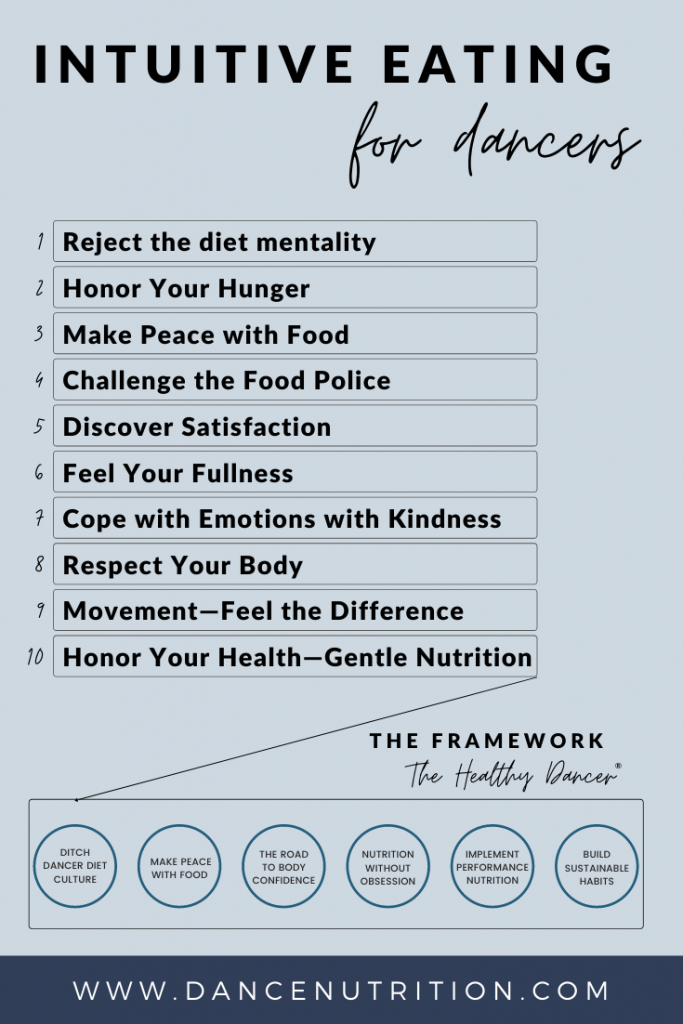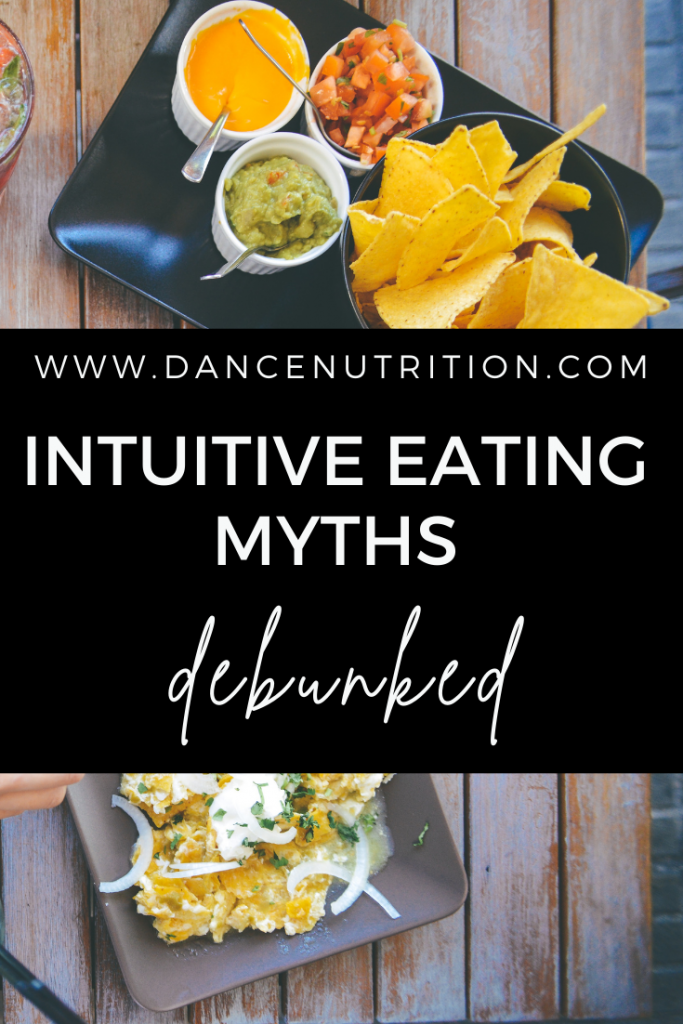You’ve likely heard the buzz around Intuitive Eating (IE), and maybe you’ve even started exploring how it fits into your life as a dancer. I’ve previously discussed what intuitive eating is and how dancers can implement these principles into their active lifestyles. But despite its growing popularity, misconceptions about this lifestyle are everywhere— and they can hold you back from fully embracing this powerful, non-diet approach. Let’s break down the most common myths and set the record straight.
Myth #1: Intuitive Eating Is All Instinct
While we’re born with the innate ability to recognize hunger and fullness, those signals quickly get overridden by diet culture. From early childhood, we’re exposed to messages about “good” vs. “bad” foods, and “healthy” vs. “unhealthy” choices— often framed through a weight-loss lens. These beliefs disconnect us from our bodies and reinforce a weight-normative view of health, which fuels stigma and marginalization of larger bodies.
Rebuilding trust in your body’s cues isn’t just about instinct— it requires unlearning years of internalized messaging. That’s why the first step in my The Healthy Dancer® framework focuses on dismantling dancer diet culture. In fact, I dedicate an entire Winter Intensive to this very topic.

Myth #2: Intuitive Eating Doesn’t Work if You “Over”-eat or Binge
Struggling with overeating or binge eating? That doesn’t disqualify you from intuitive eating— it means you may benefit from it. These behaviors are often a reaction to restriction, whether it’s biological (ie, calorie restrictions from skipping meals) or psychological (ie, food rules like “starting tomorrow, no more sugar”).
Eating intuitively doesn’t mean “moderation” or relying on willpower (more on this here). Instead, it focuses on healing the deprivation that triggers the behavior. That means learning to trust hunger and fullness cues, dismantling harmful food beliefs, and using gentle nutrition to support both the body’s physical needs— especially during times when access to food is limited. The goal? A neutral, nonjudgmental relationship with food, free from guilt, shame, and menu anxiety.
Myth #3: Intuitive Eating Isn’t for People With Chronic Health Conditions
If you live with a chronic illness, chances are you’ve received dietary advice centered around lifestyle changes, often centered on food restriction (and weight loss). This can make intuitive eating seem incompatible with disease management. But the truth is, intuitive eating can enhance your ability to manage health conditions like:
- Heart disease
- Diabetes
- Cancer
- Irritable Bowel Syndrome (IBS-D or IBS-C)
- Polycystic Ovarian Syndrome (PCOS)
- Autoimmune disorders (ie. food allergies and intolerances, Celiac disease, Hashimoto’s thyroiditis)
- Hypermobility disorders (ie. Ehlers-Danlos Syndrome)
We know that weight cycling, a common result of dieting, results in a multitude of negative health outcomes and weight stigma, the bias often experienced under the weight-normative approach to managing chronic illness, increases stress levels.
The intuitive approach encourages greater interoceptive awareness, helping you tune into your body’s signals (hunger and fullness). It also helps to remove obstacles (like food and body beliefs) that block your ability to make choices that support your health, without falling back into restrictive eating patterns.
Remember: following hunger and fullness cues makes up only a fraction of the approach. Gentle nutrition (the tenth principle of intuitive eating) can greatly benefit disease management with necessary dietary adjustments in a flexible, compassionate way. Here are a few examples:
- Avoiding gluten to reduce symptoms of Celiac Disease.
- Managing sodium for blood pressure, including individuals considered salt-sensitive.
- Understanding of the impact of carbohydrates on blood sugar in the management of diabetes, especially when exogenous insulin is administered (Interestingly, intuitive eating has shown promising results in the management of Type 2 Diabetes and heart disease)
Similarly, those who struggle with food allergies, sensitivities, or even autoimmune conditions may have a clear understanding of what foods trigger physical symptoms and what foods alleviate physical symptoms. Bottom line: decisions are based upon the need to support one’s whole being, regardless of body size.
Myth #4: Intuitive Eating Is Only for Thin People
I understand how it feels to struggle with overwhelming body dissatisfaction (a topic I talk more about here). However, I recognize my thin privilege. I live in a body that diet culture deems “acceptable.” I don’t face size-related discrimination or barriers to healthcare. And while that privilege doesn’t invalidate my expertise, it’s important to acknowledge it— especially in a space where body diversity is often excluded. I am aware that I might have limitations in my lived experience and therefore encourage additional resources like Anti-Diet and Be Nourished.
That said, intuitive eating is for everyone. I’ve worked with dancers of all body sizes, and the common outcome is a flourishing and satisfying career— free from disordered eating, body dissatisfaction, injury, and burnout caused by trying to control weight at all costs.
Myth #5: Intuitive Eating Is the Same as Mindful Eating
While mindful eating is a valuable tool in the intuitive eating toolbox, it’s not the same. Mindful eating focuses on being fully present during meals— savoring textures, flavors, and emotional cues without judgment. It can help build awareness of hunger and fullness and one’s experiences with food. The ultimate goal is to help individuals gain full presence around an eating experience, helping to guide decisions about when to stop eating.
While mindful eating techniques are used throughout the intuitive process (check out these actionable tips), intuitive eating goes deeper. It’s a dynamic, multifaceted framework that addresses emotional nourishment, dismantles diet culture, and promotes autonomy in food choices. It’s not just about how you eat— it’s about why you eat, and how those choices impact your physical and emotional well-being.
Myth #6: Intuitive Eating Doesn’t Care About Nutrition
Nutrition does matter in intuitive eating, but it’s not the only thing that matters. Dieting often elevates nutrition to the sole factor in food decisions, whereas the intuitive approach considers many factors: satisfaction, emotional needs, culture, and accessibility, alongside nutrition.
The tenth principle, gentle nutrition, helps dancers and non-dancers alike integrate nutrition science without falling into obsessive behaviors or all-or-nothing thinking. But it’s important to time it right. The closer one is to healing from diet culture, the easier it is to integrate gentle nutrition (and for dancers, performance nutrition). If you’re recovering from disordered eating or years of restrictive “clean eating,” setting nutrition aside temporarily can be essential for healing.
With gentle nutrition, intuitive eaters utilize compassionate curiosity, rather than judgment or ridicule, to assess what foods feel good physically, mentally, and emotionally. For example, you may choose a fibrous fruit for sustained energy throughout a morning rehearsal. To learn more about gentle nutrition, check out this article. And if you feel ready to integrate nutrition science into your performance (minus the obsessions), check out this self-study course, Nourish The Healthy Dancer®.
Myth #7: You Might Be Doing It Wrong
Intuitive Eating isn’t a trend. It’s a transformative way to reclaim your autonomy over food and body— and it’s 100% compatible with the demands of a dancer’s life. That said, there’s no “perfect” way to eat intuitively. If you’re not approaching intuitive eating as a weight loss strategy, you’re already on the right track. This work isn’t linear— it’s an ongoing process of compassionate exploration. You’ll try, reflect, learn, and adjust.
That’s the heart of The Healthy Dancer®: building a toolkit rooted in curiosity rather than control. And through that process, dancers rediscover food as fuel, joy, and connection, not as a system to micromanage your life and body.




